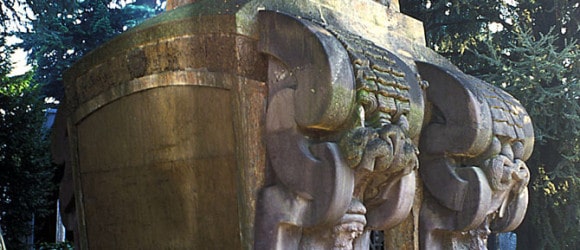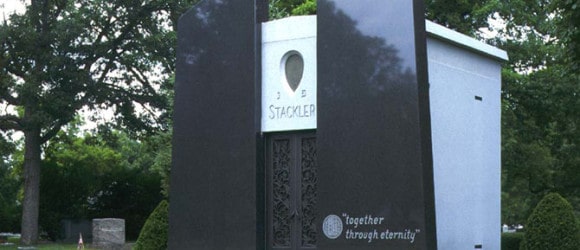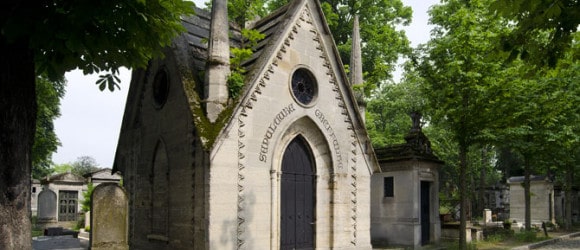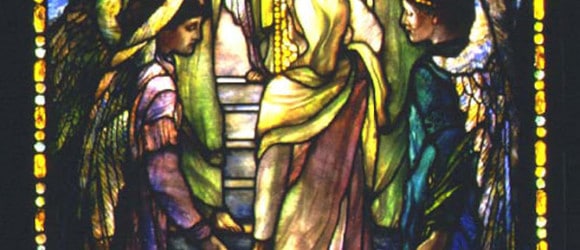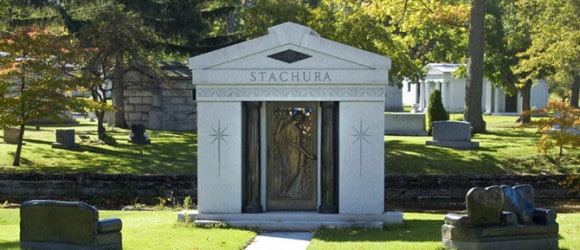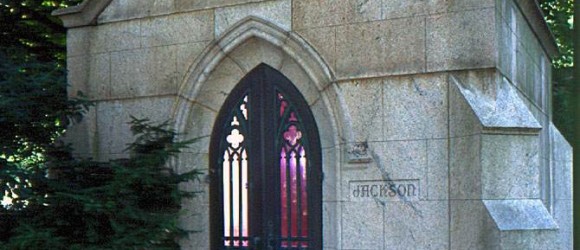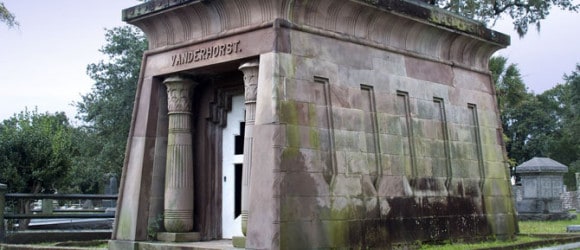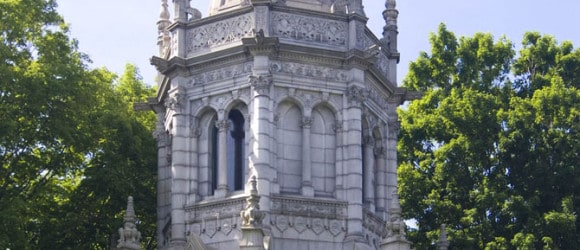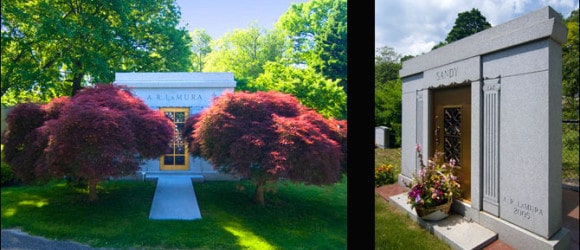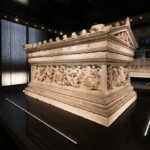Uniquely Funerary: Pierd’Houy Family Mausoleum
- At March 28, 2013
- By Doug Keister
- In Doug Keister's Blog
0
When I was photographing and researching my first cemetery book, Going Out in Style: The Architecture of Eternity, I kept coming across mausoleums that didn’t neatly fit into any definite architectural style. These eclectic mausoleums might have some Gothic spires, Classical Revival columns, and Egyptian symbolism. I started to call this odd and sometimes wonderfully whimsical architecture “Uniquely Funerary”. You just aren’t likely to find this style of architecture anywhere else but a cemetery, or perhaps a fanciful theme park. Indeed, Uniquely Funerary mausoleums and funerary structures are a triumph of form over function. They may be thought of as a delightful marriage of sculpture and architecture.
Read More»The Mausoleum Enters the Twenty First Century
- At March 27, 2013
- By Doug Keister
- In Doug Keister's Blog
0
When I first began photographing mausoleums for my book Going Out in Style: The Architecture of Eternity in 1997, my primary focus was documenting historic mausoleums, mostly from the late nineteenth century. After all, my background was in photographing historic architecture (mostly Victorian and Arts and Crafts homes). Mausoleums were simply another type of historic residential architecture.
Almost every architectural or design style eventually makes it into the cemetery. When Napoleon invaded Egypt with both soldiers and artists, it triggered a phenomenon that became known as Egyptian Revival architecture thanks mostly to a French book of drawings by Napoleon’s artists, Description de l’Égypte, published in 1809. Egyptian Revival was, of course, the perfect architectural style for cemeteries and mausoleums since almost all Egyptian architecture had something to do with death and the afterlife.
The same can be said for Gothic Revival churches, Greek temples, and Art Deco theaters. All of those styles eventually made it into the cemetery in the form of mausoleums and other monuments.
Read More»The Birth of the Modern Family Mausoleum
- At March 17, 2013
- By Doug Keister
- In Doug Keister's Blog
0
Although the birth of the mausoleum dates to the Tomb of Mausolus in Halicarnassus (now Bodrum, Turkey) constructed circa 353 BC, it wasn’t until the early 19th Century that the modern family mausoleum was established as an enduring funerary form. The first family mausoleum was erected in Père-Lachaise Cemetery in Paris, France. Père-Lachaise was established in 1804 as a result of a burial crisis in Paris. Prior to the establishment of Père-Lachaise most people in Paris were unceremoniously buried in city cemeteries and churchyards, but after centuries of burials the cemeteries became over crowded. Père-Lachaise was laid out as a bucolic environment and looked more like a park than a burial ground. More importantly, Père-Lachaise and other cemeteries that used it as a template became a canvas for monuments and mausoleums.
Read More»Stained Glass for Mausoleums
- At March 22, 2013
- By Doug Keister
- In Doug Keister's Blog
0
When I travel to cemeteries, I often hear from managers, “We have some great Tiffany windows in our private mausoleums as well as in our community mausoleums.” I’m often tempted to tell them that I doubt that, but I usually hold my comments. Why don’t I think they have some great Tiffany windows? Simply put, Tiffany windows are relatively rare in mausoleums. Truth-be-told, I have seen some spectacular Tiffany windows in private mausoleums (many worth upwards of one million dollars), but, again, they are not commonplace.
Read More»Stachura Mausoleum: Last Impressions
- At March 29, 2013
- By Doug Keister
- In Doug Keister's Blog
0
We are all familiar with the saw, “you only have one chance to make a first impression.” Conversely, you only have one chance to make a last impression. A cemetery is, arguably, the best place to make that final statement.
Like many other cemetery explorers, I’m not particularly fond of cookie-cutter flat markers or overly simple plain-Jane tombstones. As a society we have pushed death and cemeteries away, thinking that somehow we’ll lead happier lives denying and defying death. But doing all we can to avoid death makes it harder to truly embrace life. I never feel so truly alive as I do in the midst of a cemetery.
One of my early cemetery excursions took me to a graveyard at the base of Stirling Castle in Scotland. The graveyard was peppered with 17th century tradesmen’s gravestones. These modest markers told me much more than many modern tombs. Carved into the stones were winged skulls telling me that the resident believed in the existence of a soul, (the rise of Scottish Presbyterianism heralded a more promising view of the afterlife) as well as other mortality symbols. More importantly, the stones were often embellished with the tools the person had used in their life. Here were masons and carpenters and weavers and sea captains with the tools of their trade. Those tools made it easier to picture that person even though they had died centuries ago.
Read More»Neo-Gothic Mausoleum
- At March 26, 2013
- By Doug Keister
- In Doug Keister's Blog
0
Perhaps no style of architecture is so closely associated with cemeteries as Gothic. Its towers, spires, and flying buttresses are the stuff of ghost stories, dark and stormy nights, and evil sorcerers. The structural advantages of the Gothic style over other types of architecture enabled architects and designers to construct buildings and cathedrals of any size their time and budgets would permit. Because Gothic architecture did not borrow heavily from any of the pagan Classical styles, it is most closely associated with Christianity. It is, in fact, the first purely Christian architecture. Gothic architecture is easy to identify by its vertical emphasis, pointed arches, and heavily ornamented spires.
Think of the great cathedrals in Europe and you’ll get a pretty good fix on the elements of the Gothic style. The style originated in France in the 12th century and lasted another four centuries before dying out in the 16th century. When the Gothic style was reintroduced in the 19th century it was known as Gothic revival.
Read More»Egyptian Revival Mausoleum: Mausoleum Styles and Architecture
- At March 20, 2013
- By Doug Keister
- In Doug Keister's Blog
0
Egyptian is the most funerary style of architecture. After all, almost all architecture in ancient Egypt related to death and the afterlife.
American cemeteries trump American cities in their display of Egyptial architecture. While there is no denying that Egyptian Revival architecture is jam-packed with funerary symbolism, its obvious pagan origins reduces its popularity with the Christian community. Cemetery explorers find fewer and fewer examples of Egyptian Revival architecture the closer they get to the Bible Belt. However, those of the Jewish faith generally accept Egyptian architecture as much of their religious history is rooted in that region.
Read More»Classical Revival Mausoleum: Mausoleum Styles and Architecture
- At March 21, 2013
- By Doug Keister
- In Doug Keister's Blog
0
The most common type of mausoleum architecture is Classical Revival. It is easy to identify by its columns and column capitals, which are classified into “orders,” generally recognized as Doric, Tuscan, Ionic, Corinthian and Composite. Doric and Tuscan architecture developed about the same time, but most scholars think that Doric, despite having more ornamentation, emerged first.
Doric architecture can be divided into Grecian Doric and Roman Doric. The best known Doric building is the Parthenon, built in Athens around 450 B.C.. Doric architecture is identified by its tapering, fluted columns that rise directly from the base (stylobate) and are crowned by plain capitals. Roman Doric columns are also fluted and crowned by plain capitals, but have a base.
Read More»Harbeck Mausoleum
- At July 31, 2013
- By mausoleum
- In Doug Keister's Blog
0
John H. Harbeck certainly had an interesting life as well as a contentious life and afterlife. His father, William H. Harbeck, was a founding partner of a substantial warehousing empire on Furman Street in Brooklyn known as the Harbeck Stores. John Harbeck reaped the rewards of that business, made investments of his own including ones in Colorado and railroad stocks, and led a rather opulent life thanks to his comfortable financial situation. In 1870, he met one Caroline Montgomery who claimed she was about to be divorced from her scallywag of a husband, Andrew Montgomery. John’s and Caroline’s hearts soon swooned, and, by 1871, John installed her as his wife at his upscale home on West 55th Street. Caroline was his “wife,” thanks to a far-from-binding oral agreement.
Read More»Sandy the Dog Mausoleum
- At July 31, 2013
- By mausoleum
- In Doug Keister's Blog
0
A Man’s Best Friend Goes Out in Style. Let’s get one thing straight from the get-go: man’s best friend is the dog. With all due respect to the pet proclivities of lovers of ferrets, finches, hamsters, horn toads, pythons, parrots, cats, and other critters, no other creature holds a candle to the dog. Dogs rule. Just ask Tony LaMura.
Tony LaMura comes from a family of thoroughbreds—Thoroughbred Italians—100% Italian on both sides, with lots of Emestinas, Fedricos, Giuseppis, Assuntas, and Anthonys. When Tony was a kid, he had a purebred German Shepherd with the fitting name of Major. Young Tony became very attached to Major, but Major died when Tony was 12, and the young boy was devastated. Not long after Major died, Tony asked his mother if they could get another dog, but his mother said, “No,” not out of meanness but out of compassion for Tony. She just didn’t want to have him go through the inevitable loss of another pet. “You get too attached,” she told him.
Read More»